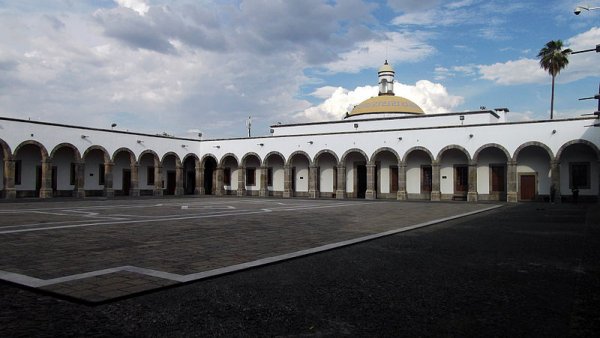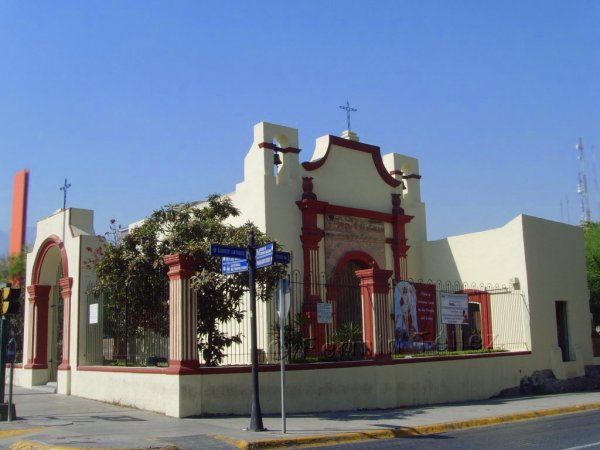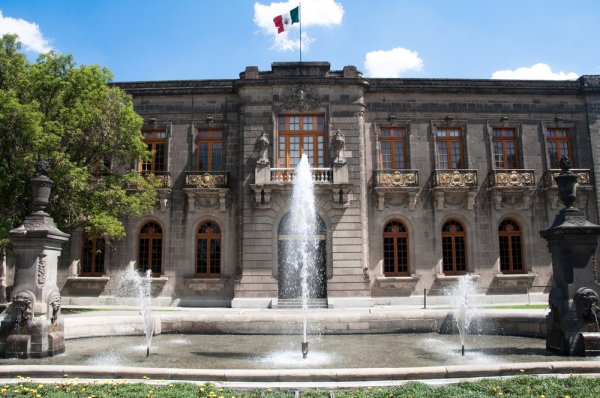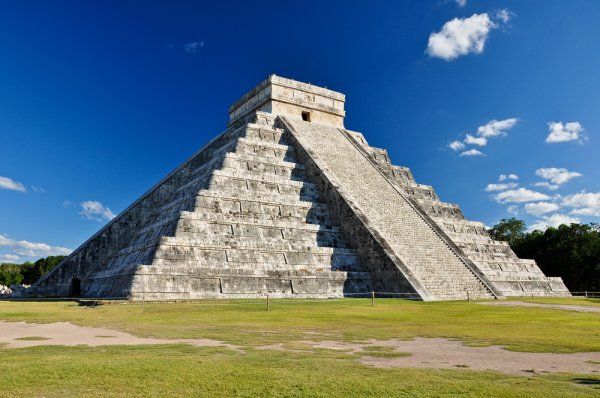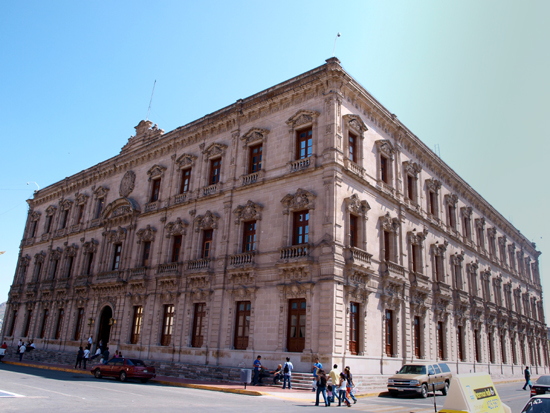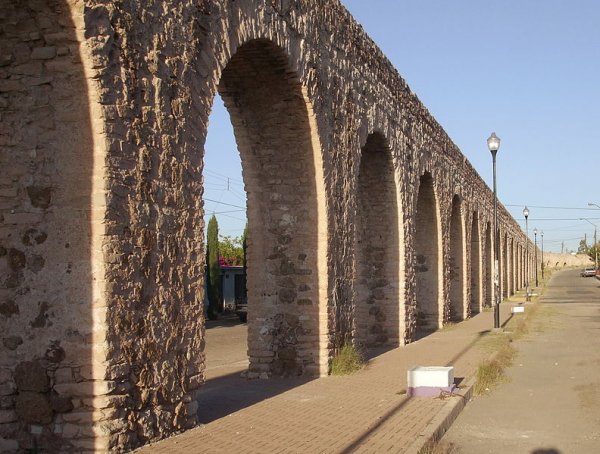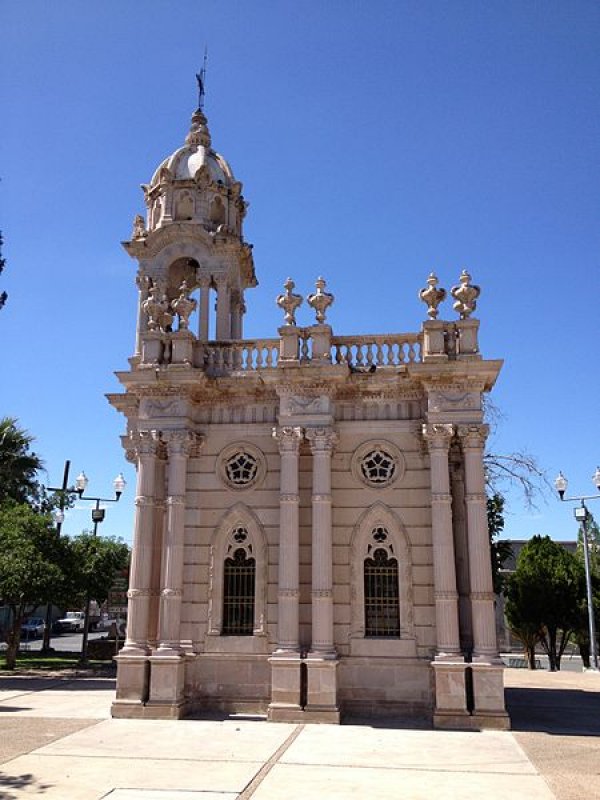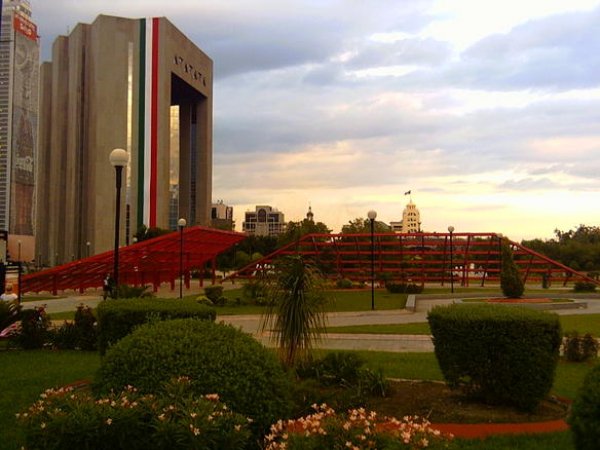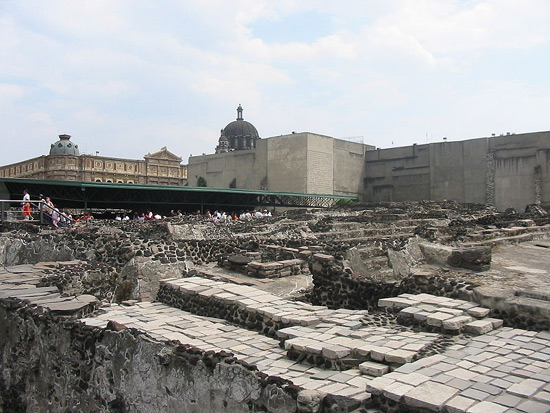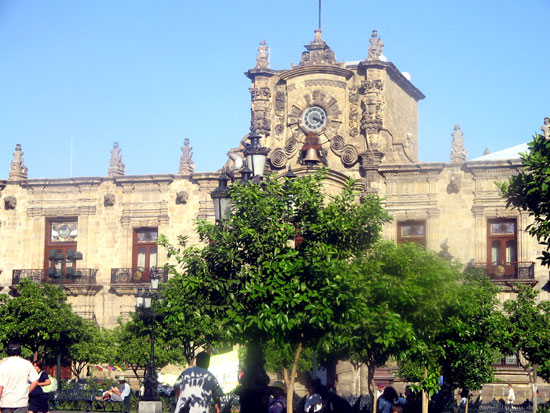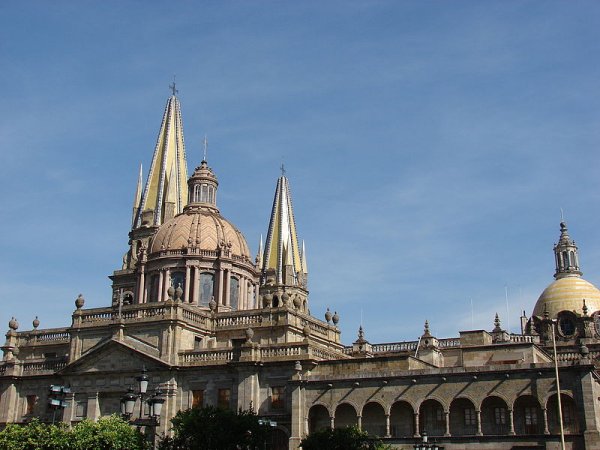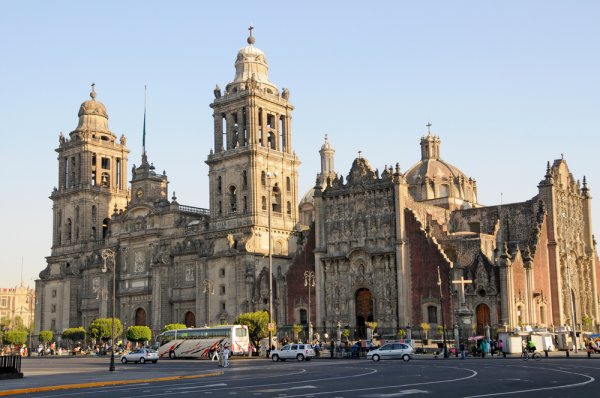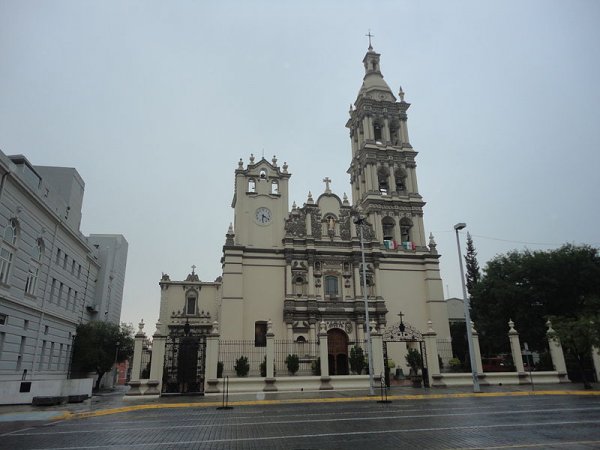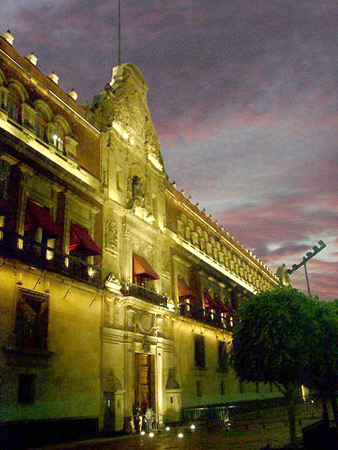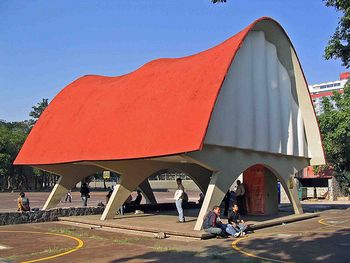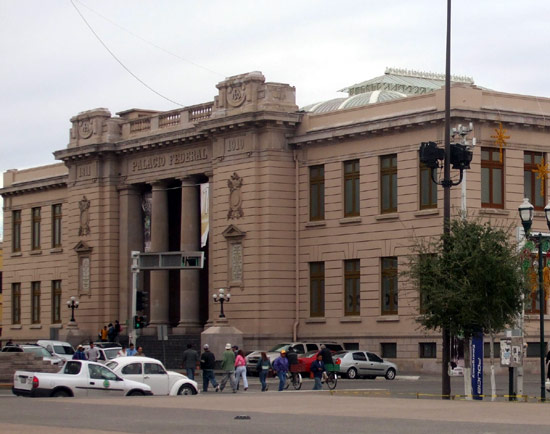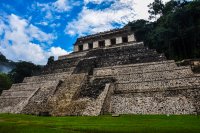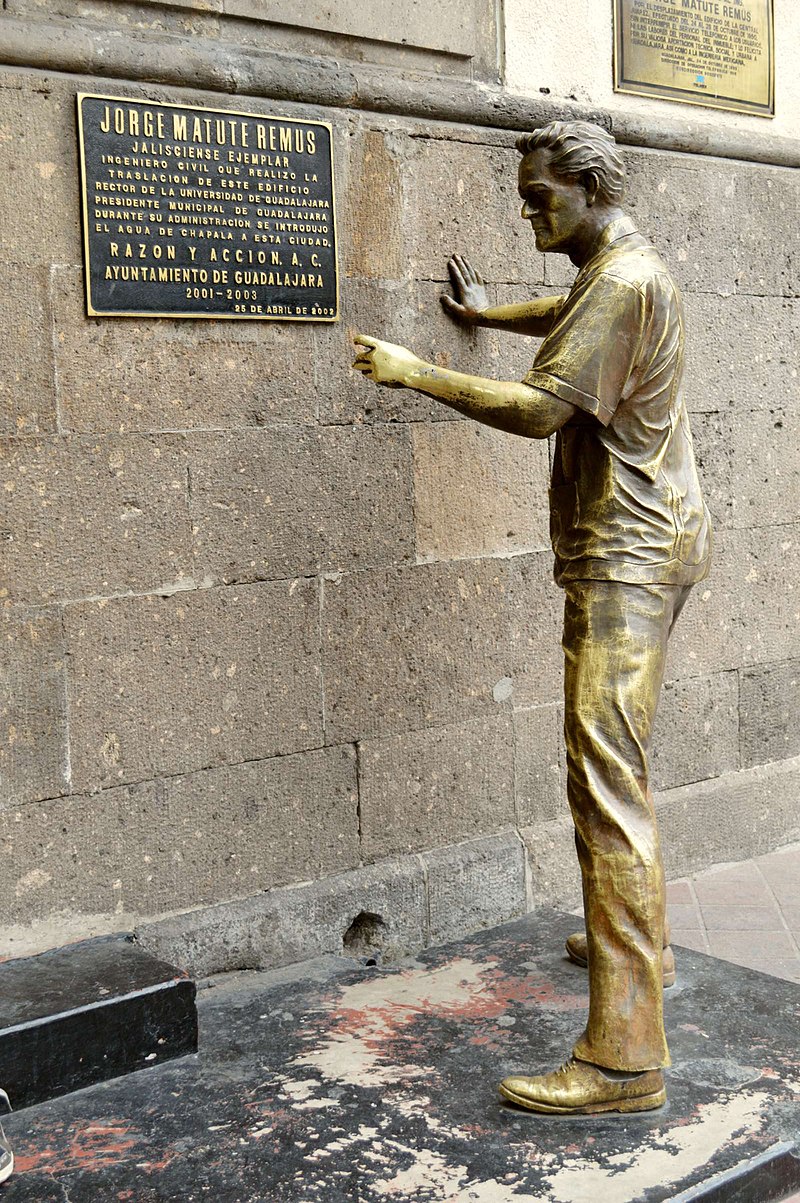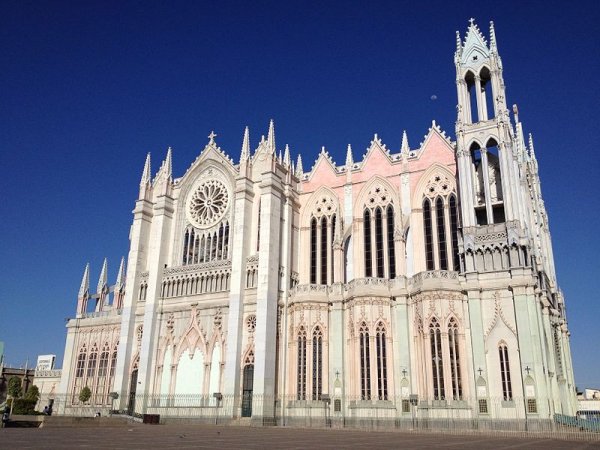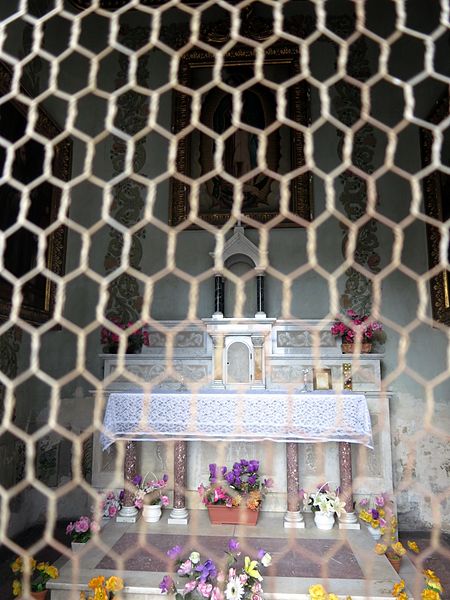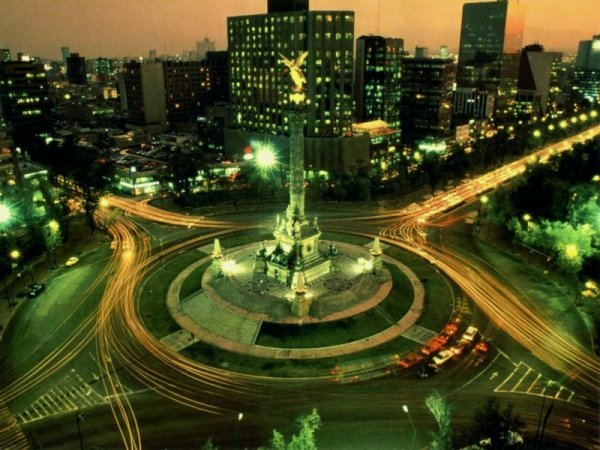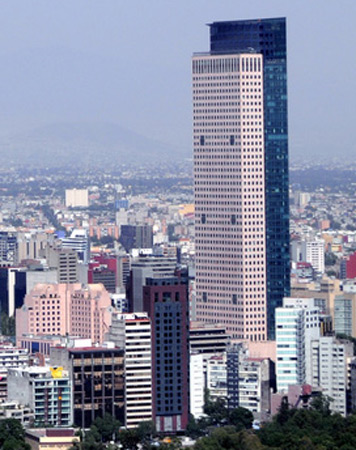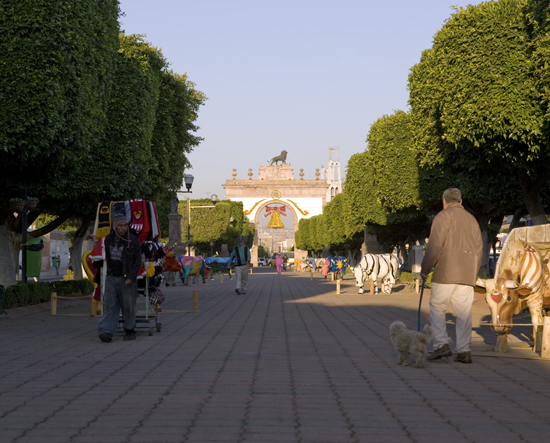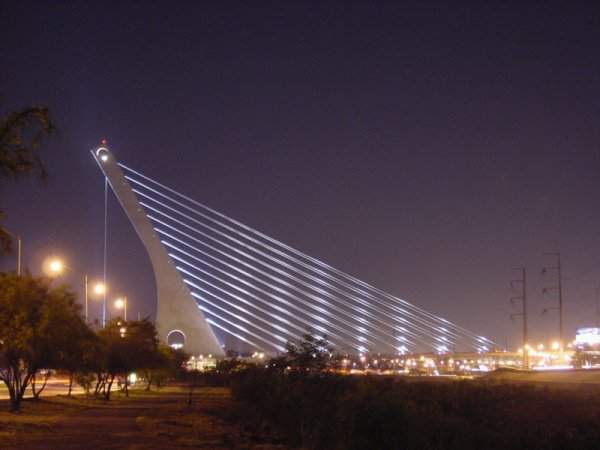Points of Interest
Basilica Cathedral of Our Lady of Light
Pedro Moreno Zona
Centro León, Mexico
The imposing, baroque León Cathedral dates back to the mid-1700s, although it was not completed until well into the 19th century. Inside the religious structure are spiritual artworks designed to protect The Virgin of Light, the city's patron saint. For history buffs, there are cathedral and surrounding grounds tours that delve further into the history and religious significance of the neighborhood.
Basilica of Our Lady of Guadalupe
Plaza de las Américas núm. 1
Mexico City, Mexico
The basilica, regarded as one of the most important Catholic pilgrim centers in the world, is dedicated to St. Juan Diego, the patron saint of Mexico. Legend has it that the Virgin Mary appeared to the saint (an Aztec who converted to Catholicism), asking him to build a church at the site. The original tilma (apron) of St. Juan Diego with the icon of Our Lady of Guadalupe is preserved in the church. Built between 1974 and 1976 by the Mexican architect Pedro Ramirez Vásquez, the basilica has a circular floor plan and nine chapels that can accommodate up to 40,000 people.
Bishop's Palace
Palacio del Obispado Rafael José Vergel Col. Obispado
Monterrey, Mexico
Called the Palacio del Obispado colloquially, this attraction's official name is really the Museo de Historia Regional de Nuevo León (Nuevo León Regional History Museum). It was converted to a museum in 1956 and depicts the history of the state of Nuevo León. Monterrey's government built the palace on el Cerro del Obispado (Bishopric Hill) in the late 18th century as a retirement home for an important bishop, Rafael José de Verger, who convinced the monarchy to move the bishop's office to Monterrey. During the Mexican-American War and other wars, the palace served as a fort. The building is now the best example of colonial architecture left in the city. Hours of operation are 10 a.m. to 7 p.m., Tuesday through Sunday (the museum is free on Sunday). The museum is closed Mondays.
Cabañas Hospice
Calle Cabanas 8, Plaza Tapatia
Guadalajara, Mexico
Founded in 1791 as a combination workhouse, hospital, orphanage, and almshouse and completed in 1829, the 164-meter (538-ft) long building now houses Instituto Cultural Cabañas, as well as affiliated schools for arts and crafts. The design features a series of conjoined 7.5-meter (25-ft) high, single-story structures circling a 15-meter (50-ft) domed chapel and 23 courtyards. In the 1930s, Mexican muralist José Clemente Orozco painted a series of monumental frescoes on the interior walls. One of these, the spectacular El Hombre de Fuego (The Man of Fire), adorns the chapel dome.
Cathedral of Chihuahua
Catedral de la Santa Cruz Plaza de Armas
Centro Chihuahua, Mexico
Built with pink quarry stone, the churrigueresque-style structure is the seat of the Archdiocese of Chihuahua. Completed over a period of 100 years beginning in 1725, the three-nave building, with two identical 40-meter-tall (131-foot-tall) towers, features an impressive dome resembling the one on Saint Peter's Basilica in Rome. Statues of the 12 apostles were added in the 19th century. The cathedral organ was brought from Germany, as was the octagonal stained-glass window that graces the facade, while the kiosk and sculptures in the adjacent Plaza de Armas originated in Italy. The Museo de Arte Sacro (Museum of Religious Art), located in the basement, holds many pieces of baroque art.
Chapel of Sweet Names
Dulces Nombres Matamoros y Dr. Coss Zona
Centro Monterrey, Mexico
Originally built in 1830, this small church is the second oldest in Monterrey after the Metropolitan Cathedral. In 1938 the government declared it part of the "patrimonio nacional," making it an official historic landmark. Even so, the church fell into disrepair and had to be restored in 1945. It escaped demolition because of its unique combination of architectural and artistic styles, including Franciscan and Tuscan. During the day, the church is open to the public, although it is an official church of the archdiocese and Mass is held regularly. It features large murals carved in stone blocks and a simple façade. The church is self-contained in a wrought-iron fence with a shady plaza that invites the weary traveler to sit and recover from the heat.
Chapultepec Castle
Castillo de Chapultepec Chapultepec Park and Polanco
11100 Mexico City, Mexico
This castle stands atop Chapultepec Hill, at a height of 2,325 meters (7,628 feet), and presently houses the National Museum. Constructed in 1785 in a baroque style, the castle has been used for several purposes during its history. Abandoned during the Mexican War of Independence, the castle later served as a military academy. The palace became the official residence of presidents during the second Mexican empire and acquired several pieces of furniture, art, and fine household items from Europe. From 1939, the castle became the seat of the National Museum of History, which houses the collections of the former National Museum of archaeology, history, and ethnography.
Chichen Itza
Pisté
Yucatan 97750, Mexico
This large pre-Columbian temple city, built by the Mayans, served as the most important political and economic center of the Mayan civilization. The Mayan, Toltec, and Aztec people have all left their indelible mark on it throughout its 1,000-year history. The great city has imposing structures including a pyramid (El Castillo), Temple of Chac Mool, Hall of the Thousand Pillars, El Caracol (an astronomical observatory), and the ball court. The buildings are richly adorned with columns and relief carvings of plumed serpents, warriors, and priests. Inner walls of the vaults have murals depicting scenes of war and daily life.
Chihuahua Government Palace
Palacio de Gobierno Plaza de Armas Centro Juarez
Chihuahua, Mexico
Built between 1882 and 1892 with ocher-colored stone from local quarries, this grand neoclassical style building is the seat of the government of the state of Chihuahua. It was severely damaged by a fire in 1921, but fully restored six years later, at which time a third floor was added. The ground floor corridors feature a set of murals painted in 1961 by Mexican artist Aaron Piña Mora Hidalgo that depicts the history of the state of Chihuahua. The eternal flame at the Altar de la Patria (Altar of the Fatherland) in the central patio marks the spot where a Spanish firing squad executed Father Miguel Hidalgo, leader of the Mexican War of Independence, in 1811. Also located here is the Museo Galería de Armas (Gallery of Arms Museum), with weaponry, uniforms, and other items from the war.
Christ the King Church
Iglesia Cristo El Rey Margaritas 15
Cancún, Mexico
Cancún's first Catholic Church features open-walled architecture and an overall noteworthy modernist design. Experience an authentically Mexican Catholic Mass, or, if you'd like to follow along better, you can attend Iglesia del Cristo Rey's English-language mass, held every Sunday at 9 a.m. (Spanish mass is at 7 p.m. on Saturdays.)
Colonial Aqueduct
Acueducto Colonial Aldama and Calle 58
Chihuahua, Mexico
Construction on an aqueduct to supply much-needed water to this dry, desert city began in 1751, but it was not completed until 1793. The structure, with arches up to 24 meters (79 feet) high, originally extended for more than 6 kilometers (3.7 miles) from the Rio Chuvíscar, but less than a kilometer remains standing.
Francisco "Pancho" Villa's Mausoleum
Mausoleo de Francisco Villa Nicolás Bravo y Calle 5
Centro Chihuahua, Mexico
Though this wedding cake of a crypt was built to house Pancho Villa's remains, the body was instead buried in the city of Hidalgo del Parral, from which it was later transferred to Mexico City. The mausoleum nonetheless remains as a monument to the revolutionary leader. The highly ornate facade features an arched gate and six 8-meter-tall (25-foot-tall) sculpted columns. The roof is topped by a 5-meter (16-foot) cupola supported by additional columns.
Gran Plaza
Macroplaza De Avenida Constitución a 5 de Mayo Oriente
64000 Monterrey, Mexico
Built in the early 1980s, this plaza is located in the heart of Monterrey. Several old buildings were demolished to make way for the square, which is regarded as one of the biggest plazas in the world. Spread over 40 hectares (99 acres), the plaza consists of various monuments, smaller plazas, and gardens. The Fuente de la Vida (Neptune Fountain), with its waters cascading over three levels of bronze sculptures by Luis Sanginio, is a beautiful sight. On the eastern side of the square stands the Faro del Comercio (Lighthouse of Commerce) by the famous Mexican architect Luis Barragán. At night, the tower beams a green laser over Monterrey and the metropolis. Pop into one of the area’s restaurants before continuing to stroll and see the plaza’s many monuments.
Great Pyramid of Tenochtitlan
Templo Mayor Seminario 8 Centro Histórico
06060 Mexico City, Mexico
Templo Mayor was the most important temple in Tenochtitlan, the Aztec city located on the site where Mexico City now stands. Built in the 14th century in honor of Huitzilopochtli, the god of war, and Tlaloc, the god of rain and agriculture, the temple was destroyed during the Spanish conquest. But the discovery of an Aztec carving in 1978 led to excavation of the ruins, which are now viewable from platforms overlooking the pit in which the ruins sit. The excavation also holds the Casa de los Caballeros Aguila (House of the Eagle Knights), which served as the home for an elite group of Aztec warriors. A museum adjoining the site holds some 7,000 artifacts discovered during the excavation as well as a model of the original pyramidal-shaped temple.
Guadalajara Government Palace
Palacio de Gobierno Corona 31
Guadalajara, Mexico
Built in 1774 as the headquarters for the Spanish-appointed governor of El Nuevo Reino de Galicia, the Palacio de Gobierno later served as headquarters for the administration of Presidente Benito Juárez during his first term in office while French forces occupied Mexico City. The government of the state of Jalisco now uses the generally neoclassical structure. The building earned a place in Mexican history when Padre Miguel Hidalgo delivered his famous 1810 Bando contra la Esclavitud (Edict Against Slavery). A large mural of Hidalgo by Mexican artist José Clemente Orozco adorns the central staircase, and another showing the priest signing the edict is found in the Congreso del Estado (State Congress) chamber on the second floor.
Los Muertos Pier
Francisca Rodriguez 121, Emiliano Zapata
48380 Puerto Vallarta, Mexico
Featuring a sleek, contemporary design reminiscent of a sailboat, Los Muertos Pier is a draw for all members of the family. With its long reach out into the ocean, a walk along this stretch offers expansive views of both nature and the urban waterfront of Puerto Vallarta. There is plenty of people watching to enjoy, and the area is popular for parasailing. Come for the day, remembering to bring swimsuits and toys for the long sandy beach. The El Centro area surrounding the pier is a funky district offering cool shops, restaurants, and strolling entertainers. This also is the spot where boats depart for the area’s southern beaches, with options to snorkel, dive, and venture out on a fishing charter located here as well. For perhaps the most memorable experience, plan for a nighttime visit when the pier is lit up and includes rotating colored spotlights. The views of the city’s sparkling lights and shimmering ocean reflection will be unforgettable.
Metropolitan Cathedral of Guadalajara
Catedral Metropolitana Avenida 16 de Septiembre
Guadalajara, Mexico
Formally known as the Cathedral of Guadalajara and Catedral de la Asunción de María Santísima (Cathedral of the Assumption of Holy Mary), this massive church was completed in 1618. Its two 60-meter (197-ft) towers rose up in 1854 to replace those destroyed by an earthquake in 1849. The cavernous interior with its large central dome will take your breath away. Designed in the Renaissance style with neo-Gothic towers, the structure features stained glass windows imported from France, altars of marble and silver, and a huge pipe organ that is among the largest in Mexico. The cathedral houses the relics of Santa Inocencia as well as the heart of a former Mexican president.
Metropolitan Cathedral of Mexico City
Catedral Metropolitana de la Ciudad de Mexico S/N Plaza de la Constitución Centro Histórico
06000 Mexico City, Mexico
Located on Mexico City's central square, this Spanish baroque cathedral is the largest in the western hemisphere. Its construction spanned the period between 1567 and 1788. The church has 64-meter-tall (210-foot-tall) neoclassical bell towers, which hold 18 bells, and a central dome designed by the Spanish architect Manuel Tolsa. The church stands on a lake bed and there has been considerable sinking owing to the soft clay subsoil. Underground tunnels and scaffolding have been added to stabilize the building. The cathedral has a vast collection of prized works of art from the colonial era, including paintings, altarpieces, and statues in full graphic color.
México City México Temple
Avenida 510 # 90 Colonia San Juan de Aragon
07950 México City, México
This temple of Jesus Christ of Latter-day Saints (commonly known as the Mormons) was dedicated in 1983 by Gordon B. Hinckley. The church stands on an area of 2.3 hectares (7 acres) and has a unique design that is based on ancient Aztec and Mayan architecture. It has a white cast stone exterior ornately decorated with ancient Mayan designs. The temple was the first of 12 Mormon temples built in México and has four ordinance rooms and 11 sealing rooms.
Monterrey Metropolitan Cathedral
Catedral Metropolitana de Monterrery Zuazua #1100 Sur Zona
Centro Monterrey, Mexico
By far the oldest church in Monterrey, the Metropolitan Cathedral also took the longest to build—165 years. Construction of the baroque cathedral began in 1626 but was not finished until 1833. The main tower was built from 1891 to 1899; in 1940 the archdiocese added a commemorative garden that faces Calle Juarez. Because it took so long to build, many Catholic leaders have left their mark on the cathedral. As a testament to its strength and solid construction, the cathedral has served as a small fort in more than one war. The cathedral, now the seat of the Archdiocese of Monterrey, is open to the public from 11 a.m. to 7 p.m. Monday through Saturday and 9 a.m. to 9 p.m. on Sunday.
Municipal Palace
Palacio Municipal Plaza Principal
León, Mexico
The façade of the neoclassical, 19th-century Municipal Palace demonstrates design mastery. Visitors are equally dazzled when exploring the interiors, flanked with prestigious works of art, as well as the Zen-like courtyard. The murals of Jesus Christ are a magnificent sight as well.
National Palace
Palacio Nacional S/N Plaza de la Constitución
06066 Mexico City, Mexico
Built in 1693 for Hernán Cortés, the Palacio Nacional now serves as the official home and office of Mexico's president. Its construction used the foundation of and many of the materials from the palace of Moctezuma II, ruler of the Aztec empire at the time of the Spanish conquest. In addition to government offices, the building houses the Archivo Nacional de México and a small museum dedicated to Benito Juárez and the Congreso de la Unión. The 200-meter-long (650-foot-long) building originally had only two stories, but a third story was added in the 1920s. In the same period, Diego Rivera painted murals in many of the public corridors, including the renowned Epica del Pueblo Mexicano en su Lucha por la Libertad y la Independencia (Epic of the Mexican People in Their Struggle for Freedom and Independence) in which 2,000 years of history are condensed onto a single wall.
Pabellón Rayos Cósmicos
Cosmic Ray Pavilion University City, Coyoacán
Mexico City, Mexico
With a curving roof and resting atop arched supports, the Pabellón Rayos Cósmicos (Cosmic Ray Pavilion) has an unusual shape that distinguishes it from almost every other building around. If you think it recalls something from a sci-fi film, you’re on the right track, as the building was designed at the request of the science faculty of the National Autonomous University of Mexico (UNAM). The scientists wanted a building that allowed them to measure high-energy radiation from space and protect its instruments from the open air. Original plans called for a dome though architect Felix Candela designed a hyperbolic paraboloid building instead. The double curves of the design resulted in a thin though stable roof that is 5/8 of an inch at its thickest point. The Cosmic Ray Pavilion is 12 meters (40 feet) by 10 meters (35 feet) and includes two laboratory spaces, though the building is no longer used as such by the university. The building is now a testament to Candela’s ingenious design and the first to use Candela’s hyperbolic paraboloid shape, one he used repeatedly in several future constructions.
Palacio Federal de Chihuahua
Federal Palace of Chihuahua 911 Venustiano Carranza
Centro Chihuahua, Mexico
Completed in 1910 to celebrate the centennial of the Mexican War of Independence, this neoclassical style building incorporates an older tower in whose basement cell revolutionary leader Miguel Hidalgo was imprisoned for 98 days. On the eve of his execution, he inscribed a poem on the wall thanking the warden and guards for their kindness. The poem was later engraved on a bronze plaque that now hangs on the cell wall. The building features a beautiful covered patio with a leaded glass ceiling with a grand double staircase leading up from it. Though built to hold offices of the federal government, today the structure houses the Centro de Patrimonio Cultural (Cultural Heritage Center).
Palenque
Near the Usumacinta River Palenque
Chiapas, Mexico
This archaeological site contains some of the finest architecture, sculptures, roof combs, and bas-relief carvings of the Mayan civilization in Mexico. The site was the capital of the Mayan Empire during the Classical period and reached its zenith between 500 and 700 CE. The Mayan Ajaw (ruler), K'inich Janaab' Pakal, is credited with reviving the city's art and architecture and for rebuilding Palenque between 615 and 683 CE. The funerary temple dedicated to him preserves lengthy inscriptions and sculpted reliefs that reveal the complex history, mythology, and ritual practices of the Mayan Classical period.
Rotunda of Illustrious Jaliscans
Rotonda de Los Jaliscienses Avenida Hidalgo and Calle Liceo
Centro Guadalajara, Mexico
This circular monument, built in 1951, consists of an open dome supported by 17 striated columns without base or capital. Each column corresponds to a statue of one of 11 historic figures from the state of Jalisco. Underneath the monument, 98 urns contain the remains of these and other famous Jaliscans. A central crypt holds the mummified body of military leader Ramón Corona Madrigal, who led the successful battle to defend the city against the French in the 1850s.
Telmex Building
506 Avenida Juárez
Guadalajara 44100, Mexico
When Guadalajara’s Juárez Avenue was widened in 1927, the building housing Mexican Telephone Company remained in place in order to avoid interrupting telephone service. It stood clogging the thoroughfare for more than 20 years until engineer Jorge Matute Remus proposed a way to move the building while its workers remained inside. The process, which involved sliding a platform under the structure so it could move along a set of tracks, took four days and was completed on October 28, 1950. Using mechanical jacks, the 1,700-ton-building was moved about 12 meters (40 feet) with the telephone operators working inside.
Temple of Atonement of the Sacred Heart of Jesus
Francisco I. Madero 721
Centro León, Mexico
Construction of this stunning Gothic temple began a century ago and it's still underway. Besides its fantastic façade and stunning stained glass windows, there are catacombs where hundred of people currently are resting in peace. Underground tours begin in the early morning and conclude by 1pm
Templo Expiatorio
López Cotilla 935
Guadalajara, Mexico
Though construction started in 1897, this monumental neo-Gothic church was not opened to the public until 1931 and not completed until 1972. At the request of Archbishop Pedro Loza y Pardave, Italian architect Adamo Boari modeled the structure after Italy's Orvieto Cathedral, with large stained-glass windows, three naves, and a soaring bell tower. In keeping with the construction techniques of the Middle Ages, the structure consists solely of stone without the use of cement or iron. Beneath the church, seven crypts are the final resting places of 1,919 people. Visitors are permitted to explore the maze of catacombs, which are dark and narrow.
The Angel of Independence
El Ángel On Roundabout over Paseo de la Reforma
Mexico City, Mexico
El Ángel, as the landmark column is commonly known, is a victory monument built in 1910 to commemorate the centenary of Mexico's War of Independence that later became a mausoleum for war heroes. The base of the column is rectangular, with each of its vertices featuring a bronze sculpture symbolizing law, war, justice, and peace. The column is crowned by the "Winged Victory," a magnificent statue of an angel holding a laurel crown (symbolizing victory) and a broken chain (symbolizing freedom). The main façade of the base bears the inscription "La Nación a los Héroes de la Independencia" (The Nation to the Heroes of Independence).
Torre Mayor
On Paseo de la Reforma
Mexico City, Mexico
Torre Mayor, constructed in 2003, is the tallest skyscraper in Latin America and measures 230 meters (755 feet) at its pinnacle. Developed by Canadian businessman Paul Reichmann, the tower is located on Paseo de la Reforma, the financial and commercial hub of Mexico City. Interestingly, the tall structure stands pat in the middle of one of the world's most active seismic zones. The building incorporates the most modern anti-quake technology and is designed to withstand an 8.5 on the Richter scale. The technology was fire-tested when a 7.6-magnitude quake hit Mexico City while the tower was still under construction, and there was no damage to the building whatsoever.
Triumphal Arch
Arco de Triunfo Calzada de los Heroes
León, Mexico
This architectural piece in the heart of León's historic city center represents the development and historical wealth of the area. Erected in 1893, it was built to commemorate victory in war against Spain and Mexican Independence. In the center of the neoclassical arch is a bronze lion, donated by local bullfighter Antonio Valdez. The lion has come to symbolize the people of central Mexico and is a popular photo spot and meeting place.
Tulum
Quintana Roo, Mexico
Tulum (wall) was primarily built as a defense against invasion but also served as an important place of worship of the descending God. Although inscriptions dated from 564 CE have been discovered at the site, it is assumed that most of the structures were built around 1300. Until the late 20th century, the local Mayan people continued to visit the temples to worship and burn incense, but their numbers began to dwindle with the heavy influx of tourists to the area.
Unity Bridge
Puente de la Unidad Sin Nombre de Colonia 29
Monterrey, Mexico
The Unity Bridge rises up from the Monterrey cityscape and dominates the horizon from either side. An inclined concrete pylon climbs 134 meters (440 feet) into the air where cables fan out from it to hold up the bridge. This unconventional, asymmetrical piece of modern architecture crosses the Santa Catarina River and connects Monterrey to San Pedro Garza García. The bridge is 304 meters (1,000 ft) long and has four lanes of traffic. Completed in 2003, the project met with some opposition because of its cost and the fact that the Santa Catarina River is dry for most of the year. The locals sometimes call it "Puente Atirantado" (Cable-Stayed Bridge) after its architectural style of hanging cables. At night the bridge is decorated with colorful lights.
Copyright © 1993—2024 World Trade Press. All rights reserved.

 Mexico
Mexico 


